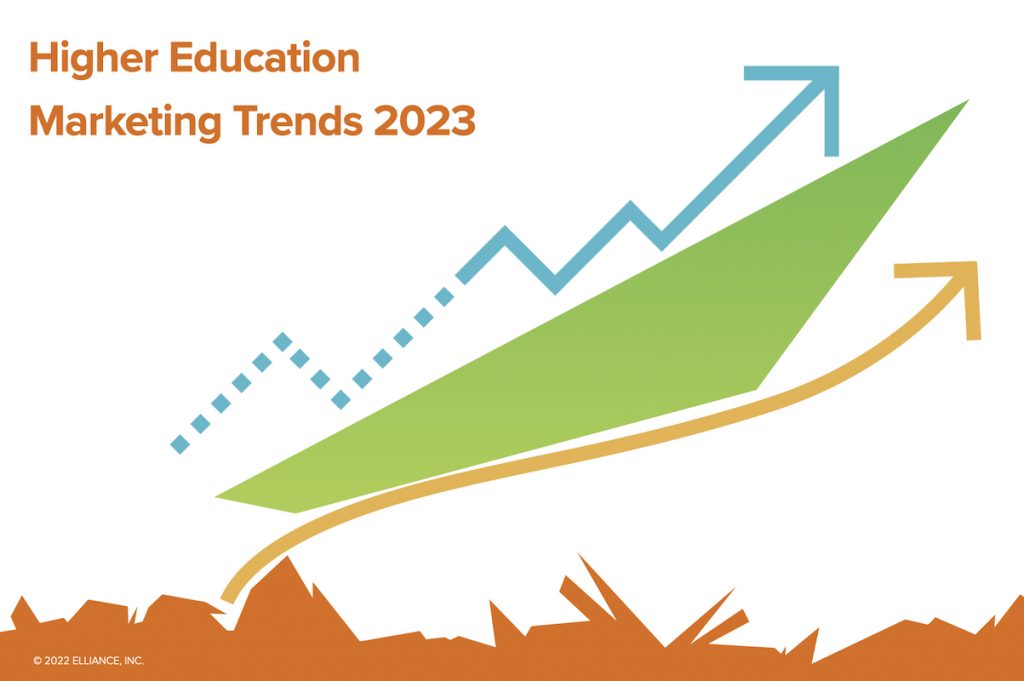| Nov 28, 2022
Higher Education Marketing Trends for 2023

As one of the top higher education marketing agencies, we are frequently asked to share our thoughts on emerging trends in this space. Here is what we are seeing.
The past two years have seen a historic decline of more than one million students in US colleges and universities. Racially and ethnically diverse student populations continue to grow. The number of International students shrank during the pandemic but are growing again. College endowments surprisingly grew at first and then took an inflationary hit. The race to win the marketing and enrollment game is on. Colleges are battling to win an outsized share of a shrinking pool of domestic students, and facing stiffer competition for international students.
Here are the top twelve higher education marketing trends for 2023 that we are sharing with our clients and partners:
1. Merchandising of Hope and Support Services
The Covid pandemic has precipitated a crisis of mental health and a need for support among young people and their families. To combat it, colleges are telling stories of hope, resilience and fortitude. More importantly, they are reassuring students and families with a renewed emphasis on counseling services, peer support groups, and activities focused on their well being.
2. Humorous and Authentic Content
Born in the digital age, Gen-Z live on Snapchat, TikTok, Instagram, Twitter, Netflix and Google. The internet is an extension of their brain. They have an app for everything they do, or have an interest in. Memes are a part of their daily lives. They expect authentic, show-don’t-tell marketing. They have a deeper appreciation and need for humor because they feel overwhelmed by the existential crisis that they are facing in weaker families, divided politics, rising costs of education, climate change, and a shrinking world. Marketers are responding.
3. Keyword Lexicons
Before marketers embark on the content journey, they are now beginning to craft SEO Keyword Lexicons that guide creation of all new content. The Lexicon is comprised of keywords and key phrases the college should rank for and claim. Keyword categories in the Lexicon include: program, brand positioning, reputation, decisioning, and location.
4. Content/Blog Marketing
Great content is the lifeblood of successful brands. “Juiced” with keywords, informative blog posts are one of the most effective means of securing Google page one rankings for long tail keywords. Depending on the type of college and university, they are increasingly either creating thought-leadership blogs or advice-oriented blogs with practical content.
5. Democratization of Research
A trend we are seeing emerge is what I call the TED-effect: faculty and thought leaders sharing their expertise in a democratized style via blogs, videos, and podcasts.
6. Celebration of Diversity, Equity and Inclusivity
Given that diverse student populations are growing and the white student population is shrinking, higher education marketers are increasingly targeting diverse Gen-Z populations. Since Gen-Z values a broad definition of diversity, equity, inclusivity, and climate justice, they are seeking out colleges whose values are aligned with theirs. Marketers are amplifying their values.
7. Authenticity in Advancement Communications
Jim Langley of Langley Innovations captures the mood amongst donors as he works with clients to test cases for support as well as specific initiatives. “What has become so apparent is that donors are evaluating these documents on the basis of their authenticity – which they measure by straight talk, a willingness to acknowledge weaknesses as well as tout strengths, avoiding overstatement and hyperbole and using humor. It’s as if donors are saying, ‘Get off your high horse and talk to me like a colleague.'” It’s time for advancement communications to be candid, authentic and meaningful.
8. Responsive Ads
Machine learning has arrived. Google algorithms are creating responsive Google search ads and Google display ads. For search ads, marketers generate multiple headlines and descriptions, and Google tests different combinations, serves the performing ads, and starves the non-performers. Ditto for display ads: marketers upload several images, sizes, headlines, descriptions, and Google adapts fast and gravitates automatically towards the winning combinations.
9. Look-Alike Audiences
Look-alike audiences are groups of prospects who share similar characteristics with the current students at a college. They tend to become applicants at a faster rate than prospects in the open market. Marketers are leveraging look-alike audience features on the advertising platforms.
10. Personalization
This smart software treats prospects differently depending on where they are coming from and where they are in their decision cycle. Treating warm prospects, hot prospects and hottest prospects uniquely reflects not only good manners but is also good for business. Personalization is increasingly being deployed in websites, emails, event marketing and advertising.
11. Influencer Marketing
Gen-Z tend to follow many influencers and generally trust what likable influencers are promoting. Social media account takeovers by students are now an effective means of bringing authentic voices to college marketing.
12. Emerging Website Norms
Colleges are using photographs of diverse students, faculty, and staff. Investigative reporting and high-octane storytelling are becoming the cornerstone of great websites. Signature program pages are being constructed with higher content fidelity. “Hamburger menus” are now routinely appearing for site navigation. Sticky admission funnel intakes, like call-to-action buttons, are becoming common.
Contact us if you are seeking a smart higher education marketing agency which can help you join the elite group of colleges we have helped prosper.
